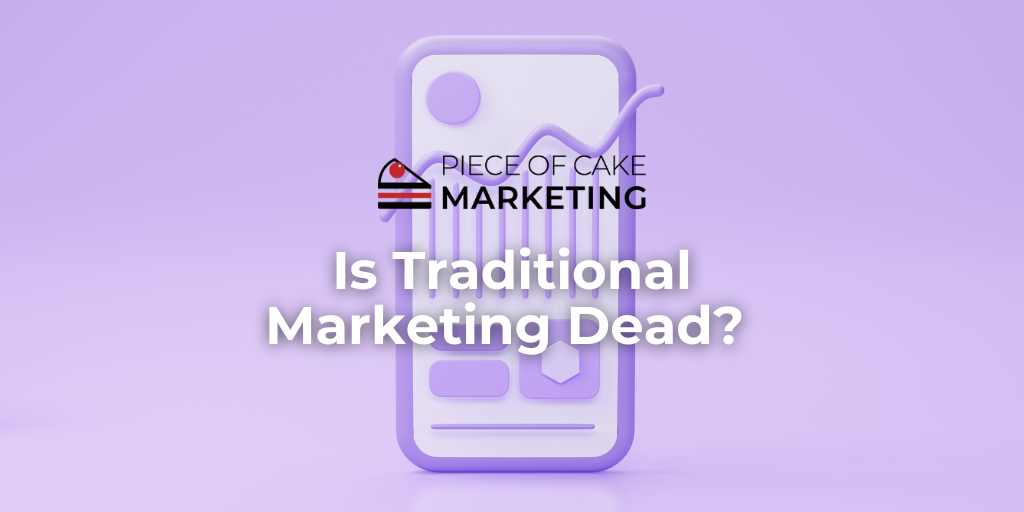When meeting with new clients the conversations tend to be dominated by social media marketing as that is what causes them their biggest issue. But traditional marketing should still hold an important place in any businesses marketing strategy.

What is Traditional Marketing?
Traditional marketing embodies the conventional methods employed to convey brand messages to a broad audience. Often tied to familiar avenues such as television, radio, print publications, and billboards, its definition expands beyond mere channel selection. More than the platforms utilised, traditional marketing encapsulates the essence of strategic content creation and deployment. It revolves around crafting compelling narratives, designing visually impactful advertisements, and strategically placing these messages where they can resonate most effectively with the intended audience. It emphasises the art of storytelling, leveraging visual and auditory cues to establish brand recall and evoke emotional connections with consumers. This approach aims to reach a wide demographic, utilising established media channels that have historically served as primary conduits for mass communication. However, the definition is not limited to specific mediums; rather, it encompasses a mindset centred on creating engaging, persuasive content and deploying it through channels with broad reach and influence.
Understanding traditional marketing goes beyond recognising the mediums themselves; it delves into the core principles of brand messaging and consumer engagement. It involves tailoring marketing initiatives to suit the preferences and behaviours of the target audience. Whether through impactful visuals in print media, catchy jingles on the radio, or memorable slogans on billboards, traditional marketing seeks to leave a lasting impression. Additionally, the essence of traditional marketing lies in its ability to convey a consistent brand image across various touchpoints, fostering brand familiarity and trust among consumers. While digital marketing has seen exponential growth and offers intricate analytics, traditional marketing endures as a fundamental cornerstone, representing the legacy and time-tested strategies that have shaped the marketing landscape for decades.
Advantages of Digital Marketing
The exponential growth of digital marketing heralded a new era in advertising, marked by many advantages that revolutionised how businesses interact with their audiences. Foremost among these advantages is the access to precise and intricate analytics. Through sophisticated tracking tools and data analytics platforms, digital marketers can measure the performance of advertisements. Metrics such as click-through rates, conversion rates, audience demographics, and engagement metrics provide invaluable insights into campaign effectiveness.
This data-driven approach empowers marketers to make informed decisions in real-time, optimising campaigns on the fly to maximise impact and return on investment. The agility afforded by digital marketing allows for swift adjustments based on performance data, ensuring resources are allocated where they generate the most significant impact.
However, amid the digital realm’s vast opportunities lies a challenge: the saturation of online spaces. The exponential proliferation of content has created a crowded and competitive landscape, making it increasingly arduous to stand out and capture the attention of the target audience. As the digital space becomes inundated with advertisements and information, the battle to cut through the noise and engage effectively with consumers intensifies. Marketers grapple with strategies that not only resonate with their audience but also differentiate their brand amidst the constant deluge of content vying for consumer attention. So, while digital marketing offers precision and adaptability, the competition for visibility needs a strategic approach to break through the digital clutter and forge meaningful connections with audiences.
The Relevance of Traditional Marketing

So, is traditional marketing obsolete? Our stance remains a firm “no.” In today’s marketplace, it’s more imperative than ever for businesses to adopt a comprehensive marketing strategy that embraces various mediums. A successful approach involves a blend of traditional and digital methods, tailored to suit the unique needs and objectives of each business.
Whether we are talking about traditional or digital, an integrated approach gets the best results. While digital marketing offers data-driven insights and adaptability, traditional avenues hold sway in creating brand impressions. Both realms amplifies brand visibility, fosters customer engagement, and cultivates long-term relationships.
Businesses who continually adapt their marketing strategies to evolving consumer behaviours and technological advancements will stand out from the rest.
Businesses Effectively Using Traditional Marketing Techniques
Here are some examples of UK businesses that have effectively used traditional marketing strategies in recent years –
– Cadbury – The chocolate brand revived nostalgic feelings with vintage-style Cadbury chocolate bar wrappers and classic TV ads set in football stadiums. This tapped into heritage and nostalgia.
– Burberry – The luxury fashion house relied on traditional outdoor print advertising showcasing English actors and landmarks. This maintained their sophisticated British aesthetic.
– HSBC – The bank launched an integrated TV, radio, and print campaign focused on their sound branding, tying back to their established tagline.
– Gymshark – The fitness apparel company used iconic London double-decker buses wrapped with their branding to create a splash and increase local brand awareness.
– Morrisons – The supermarket chain invested heavily in TV ads, promotional magazine inserts, and sponsorships aiming at families and traditional values to compete.
– Fuller’s Brewery – The British brewer maker leveraged traditional pub advertising through posters and neon signs to maintain heritage and appeal to regulars.
– The National Trust – This heritage charity focused on print member magazines and direct mail campaigns to engage their older donor base.
While incorporating modern marketing, these UK brands have proven selectively blending traditional strategies can still effectively complement their positioning and audience appeal.
Traditional and Digital Strategies Working Together
As we navigate this dynamic terrain, the mantra remains: adaptability, integration, and a keen eye on the ever-evolving consumer landscape. Traditional marketing isn’t dead—it’s an integral piece of the cake that forms a robust marketing strategy.
Investing in a Marketing Strategy
Not quite sure where to start with a marketing plan? Investing in a marketing strategy with us at a cost-effective price is a wise decision that can significantly impact the future success of your business.
Reach out to Piece of Cake Marketing today at hello@pieceofcakemarketing.co.uk or call Emma at 07799626332 to unlock the full potential of your business through the excellence of a strategic marketing approach that doesn’t break the bank. You can view our price list here.
